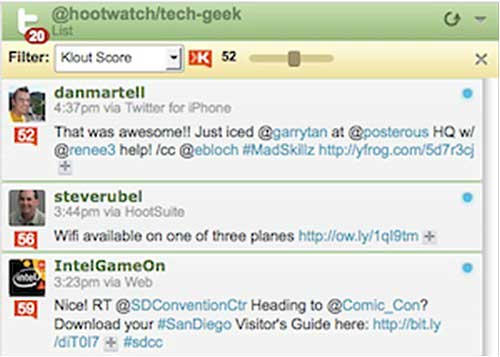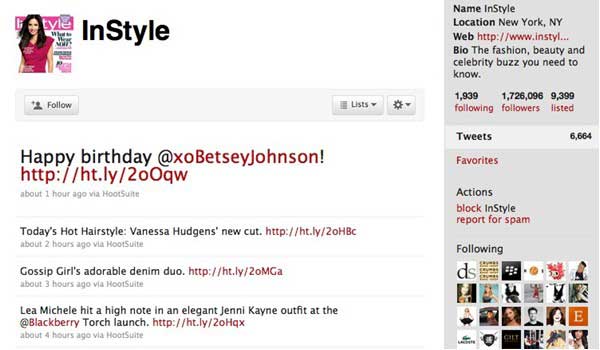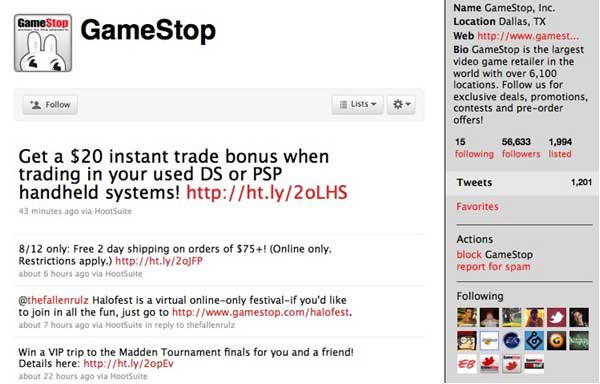Today's discussions no longer center on whether a brand should participate in social media. Companies of all sizes, across all industries, are rushing to create their Facebook page and Twitter account.
But there's more to Twitter than amassing followers and broadcasting your latest news. The real-time conversations that fill the Twitterverse offer an abundance of market insight and unprecedented visibility into consumer sentiment.
Moreover, properly engaging in the right discussions can earn customer goodwill and brand awareness.
Here are 10 tips to make sure you're making the most of Twitter for your brand.
1. Track conversations about your brand
People are talking about your company and products throughout the social Web—and each mention is an opportunity for you to engage those people. Track your brand names and product terms. Don't forget to include common misspellings.
And remember, the names or terms used internally at your company may not necessarily be the same lingo used by your customers. Use Google Analytics to learn commonly used names and terminology, and make sure to include those keywords and phrases in your brand tracking.
When you see an interesting mention about your brand, dive into the conversation to give instant support, advocacy, or thanks. If you come across a complaint, engage directly to remedy the issue; you just might be able to turn a vociferous critic into a key supporter.

2. Track industry keywords
Look beyond your brand and follow any general terms that are relevant to your market. Chime in on relevant discussions to share your expertise, guidance, or point of view. In such conversations, successful brands are participants, not promoters. This is the time to say "We love llamas too!"—not "Check out our products."
And whether you're monitoring words related to your industry or brand, always listen and learn. Tapping into the dialogue on Twitter gives you a real-time focus group to help drive innovation and adaptation.
Establish proper processes and channels to make sure important feedback reaches the right individuals and teams within your company.
3. Track public comments about your competition
Use Twitter to gather critical market intelligence by keeping a close eye on any mentions of your chief competitors. Of course, just remember your own tweets and mentions are in the public timeline as well—instantly available to anyone who's looking. Keep that in mind when crafting what to say and how to say it.
4. Measure success
As with any marketing campaign, metrics provide valuable insight into what's working and what should be tweaked. Analyzing campaign results not only helps justify investment into social media programs but also sheds light on priority areas to focus your attention and resources.
For Twitter campaigns, consider more than number of followers. Track the total number of clicks per day for each of your Twitter accounts. Break down that data by geographic region and time/date to see where and when you're having the most impact.
And most important, make sure this data gets to where it can have the greatest impact by sharing weekly, easy-to-digest reports with key managers.
5. Know your influencers
Any successful community manager or marketer understands the importance of reaching key influencers. Browse the Klout https://klout.com/ influence scores of your followers to identify potential ambassadors who can help spread your message. Search the Twitterverse for people talking about keywords relevant to your brand and sort them by influence scores.
Once you've assembled your target list, directly engage your influencers with exclusive offers, sneak previews, or just friendly acknowledgment.
For example, Starbucks offered free samples of its Pike Place Roast to the top influencers on the topic of coffee. Virgin America offered free flights between Toronto and San Francisco/Los Angeles to key influencers with high Klout scores.

An example of Hootsuite filtering of followers by Klout score to identify key tastemakers
6. Target your messaging
Each community develops a unique culture, lexicon, and protocol. Before engaging, immerse yourself in the community to learn those nuances, then tune your Tweets accordingly.
For example, updates on Twitter often use abbreviations and acronyms that are widely understood within Twitter but don't make sense if used on Facebook. "RT", the @ symbol, or hashtag (#) slug are nonsensical when viewed outside Twitter.
7. Optimize campaign schedules
Effective Twitter campaigns deliver your message at the right time and place. Schedule your campaigns to reach your target audience at the time when they're most likely to be online—whether it's small business professionals in the UK or teenagers in Japan.
Create an editorial calendar for your social campaigns to ensure your brand stays relevant throughout the year. Using a Twitter client with a built-in scheduler gives you "set it and forget it" convenience for managing your long-term tweets.
8. Offer something of value
Campaign success doesn't depend on scheduling and messaging alone. Give people a reason to follow your brand. For example, offer discounts and promotions.
By providing access to exclusive content, you'll make your followers feel like VIP superstars. And people are more apt to share content when they can be the news-breaker within their network.


9. Collaborate across teams
If you're dealing with multiple accounts and teams, use a Twitter dashboard or client tool to simplify collaboration. For each account, establish a designated person in charge, along with team members who can contribute and monitor conversations.
Be sure to integrate your Twitter activity with a broader Social CRM strategy, whereby all inbound interactions are cataloged, assigned to the right team/individual, addressed, and analyzed for future learning.
10. Above all else, be human
Remember that social networks connect people. Let the unique personalities of each person who tweets for your brand shine through.
When teams are involved on an account, each person should append editor initials to each tweet, thus providing greater accountability (i.e., who sent that tweet?). Most important, doing so allows your customers and fans to get to know the faces behind your brand.
Conversations become more natural when customers know the person they're talking to and feel like they have a friend on the inside.
* * *
If you're apprehensive about getting started, test the waters first. Put on your consumer hat and find a few brands you admire. Follow those brands' Twitter approach for a month to see what works and what doesn't.
Of course, social media is not one-size-fits all, and no one gets it 100% right immediately. Once started, your own strategy will be a continual work in progress based on daily experiences and lessons.
For more-advanced tips (particularly for agencies that wish to customize Twitter for their clients), see HootSuite's latest whitepaper (www.hootsuite.com/whitepaper).



